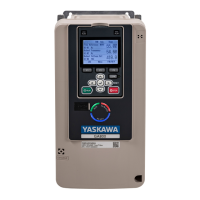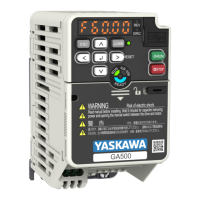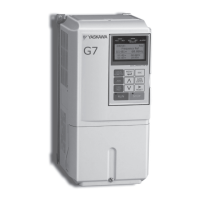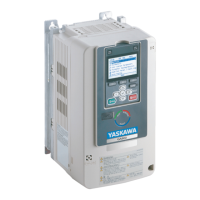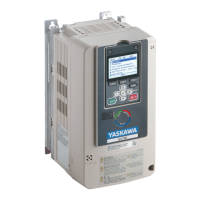Parameter Details
11
11.8 H: Terminal Functions
YASKAWA ELECTRIC SIEP C710617 05F YASKAWA AC Drive GA700 Technical Manual 921
Note:
Configuring this function disables the frequency reference set with b1-01 [Frequency Reference Selection 1].
■ D: Frequency Bias
Setting Function Description
D Frequency Bias
Enters the bias value added to the frequency reference ifE1-04 [Maximum Output Frequency] is
100%.
The drive adds the input value from the MFAI terminal set with this function to the frequency reference as the bias
value. If you select d1-xx as the frequency reference, it will disable this function.
■ E: Motor Temperature (PTC Input)
Setting Function Description
E Motor Temperature
(PTC Input)
Uses the motor Positive Temperature Coefficient (PTC) thermistor to prevent heat damage to the
motor if the current value when the 10 V (or 20 mA) analog signal is input is 100%.
• You can use the Positive Temperature Coefficient (PLC) thermistor as an auxiliary or alternative detection
function for oL1 [Motor Overload] problems to help prevent heat damage to motors. If the PTC input signal is
more than the overload alarm level, oH3 [Motor Overheating Alarm] will flash on the keypad.
• When the drive detects oH3, the motor stops with the setting in L1-03. When the drive detects oH4, the motor
stops with the setting in L1-04. When the drive incorrectly detects motor overheating problems, set L1-05.
■ F: Not Used
Setting Function Description
F Not Used
Value for terminals that are not being used or terminals being used in through mode.
When you set a terminal that is not in use to F, you can use the signal input to the terminal as PLC analog signal
input through MEMOBUS/Modbus communications or the communication option. This input signal does not
have an effect on drive operation. This functions the same as setting 1F (Through Mode).
■ 10: Forward Torque Limit
Setting Function Description
10 Forward Torque
Limit
Enters the forward torque limit if the motor rated torque is 100%.
WARNING! Sudden Movement Hazard. Set correct torque limits for applications, for example elevator applications. If you set
torque limits incorrectly, motor torque that is not sufficient can cause damage to equipment and cause serious injury or death.
Torque Limit Configuration Method
Use one of these methods to set torque limits:
• Use L7-01 to L7-04 [Torque Limit] to set each of the 4 torque limit quadrants.
• Use MFAIs to set each of the 4 torque limit quadrants. Set H3-02, H3-06, or H3-10 [MFAI Function Select] to
10, 11, or 12 [Forward/Reverse/Regenerative Torque Limit].
• Use MFAIs to set all 4 torque limit quadrants at one time. Set H3-02, H3-06, or H3-10 to 15 [General Torque
Limit].
Figure 11.112 shows the configuration method for each quadrant.

